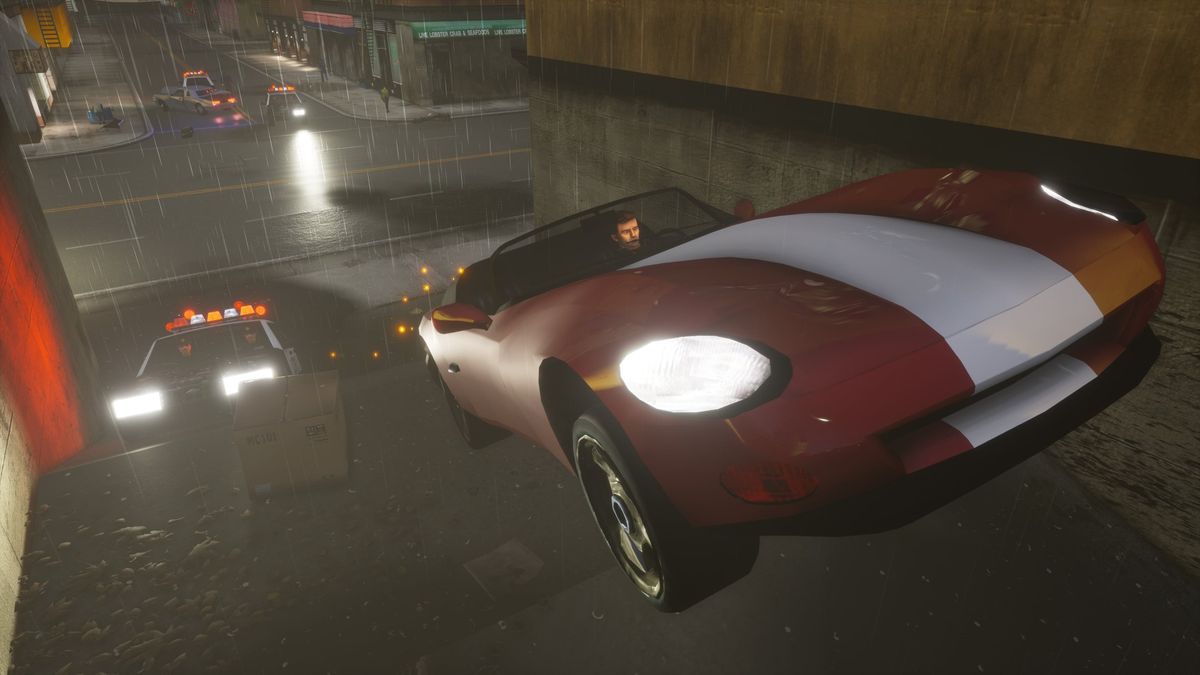From Commuter’s Lull to Gaming Revolution: The Unlikely Birth of a Cinematic Masterpiece
As we delve into the world of Grand Theft Auto 3, we often talk about its groundbreaking 3D gameplay, open-world design, and the sheer scale of its digital landscape. But behind the scenes, there’s a fascinating story of innovation and creativity that paved the way for one of gaming’s most iconic franchises. It all started with a mundane commute, a notion that might have seemed dull to anyone else, but for the talented team at Rockstar Games, it sparked a revolutionary idea that would change the face of gaming forever. In this article, we’ll take a journey back in time to explore how a simple train ride led to the creation of the series’ cinematic camera, a game-changer that would elevate the Grand Theft Auto series to new heights. Buckle up and join us as we uncover the story of how boredom became the catalyst for gaming greatness.
From Boredom to Innovation
Obbe Vermeij, the former technical director at Rockstar Games, has revealed the origins of the iconic cinematic camera feature in the Grand Theft Auto series. According to Vermeij, the concept was born out of a rather mundane train ride, which he initially found boring.
Vermeij’s initial thought process involved letting the player jump ahead to the next station, but this idea was quickly scrapped due to the potential streaming issues it would cause. Instead, he opted for a more innovative approach, making the camera switch between random viewpoints near the track. This decision proved to be a turning point in the development of the cinematic camera.
The Problem of Streaming Issues and the Need for a Solution
The potential streaming issues associated with allowing players to jump ahead to the next station were a major concern for Vermeij and the development team. If the player were to jump to a new destination, the entire map would need to be loaded in an instant, which would have resulted in a less-than-ideal gaming experience.
To mitigate this issue, Vermeij implemented the cinematic camera feature, which involved switching between random viewpoints near the track. This not only addressed the streaming issues but also added an extra layer of depth and immersion to the game.
The Unexpected Breakthrough: Switching Between Random Viewpoints
The decision to switch between random viewpoints near the track proved to be a groundbreaking moment in the development of the cinematic camera. This feature not only enhanced the gameplay experience but also paved the way for future innovations in game design.
Vermeij’s willingness to experiment and take risks paid off, and the cinematic camera feature became a staple of the Grand Theft Auto series. The team’s reaction to this new feature was overwhelmingly positive, with many finding it to be surprisingly entertaining.
The Cinematic Camera Takes Center Stage
The cinematic camera feature quickly became a fan favorite, and its impact was felt throughout the Grand Theft Auto series. In Vice City, the feature remained largely unchanged, but in San Andreas, it underwent a significant revamp at the hands of Derek Ward.
Ward, who joined the development team after completing Manhunt, brought a fresh perspective to the cinematic camera feature. His revamped version added new depth and complexity to the game, cementing the feature’s place in the series.
Applying the Concept to Cars and the Wheel Cam
The cinematic camera feature was not limited to train rides alone. The team’s innovative approach was soon applied to cars, with the addition of the wheel cam and the view from chasing cars. This expansion of the feature added a new level of realism and immersion to the game.
The wheel cam, in particular, allowed players to experience the game world in a more visceral way, with the camera positioned directly behind the vehicle’s wheel. This feature added a new level of intensity to the gameplay experience, making players feel more connected to the action.
The Team’s Surprising Reaction and the Camera’s Staying Power
The team’s initial reaction to the cinematic camera feature was one of surprise and delight. The feature’s staying power can be attributed to its innovative design and its ability to enhance the gameplay experience.
The cinematic camera feature has remained a staple of the Grand Theft Auto series, with each new iteration building upon the previous one. Its impact can be seen in the series’ ability to push the boundaries of game design and storytelling.
Evolution and Legacy: From GTA 3 to Red Dead Redemption 2
The cinematic camera feature has undergone significant changes and upgrades throughout the Grand Theft Auto series. In Vice City, the feature remained largely unchanged, but in San Andreas, it underwent a significant revamp.
The revamp was courtesy of Derek Ward, who brought a fresh perspective to the feature. His revamped version added new depth and complexity to the game, cementing the feature’s place in the series.
Changes and Upgrades in Vice City and San Andreas
While the cinematic camera feature remained largely unchanged in Vice City, it underwent significant changes in San Andreas. The revamp added new depth and complexity to the game, making it a more immersive experience for players.
The changes made to the cinematic camera feature in San Andreas were a result of the team’s desire to enhance the gameplay experience. The feature’s impact can be seen in the series’ ability to push the boundaries of game design and storytelling.
Derek Ward’s Revamped Cinematic Camera and Manhunt Connection
Derek Ward’s revamp of the cinematic camera feature in San Andreas was a significant departure from the original design. His fresh perspective brought a new level of complexity and depth to the game, making it a more immersive experience for players.
Ward’s connection to the Manhunt series is an interesting footnote in the history of the cinematic camera feature. His experience working on Manhunt likely influenced his approach to the feature, adding a new level of intensity and realism to the game.
The Cinematic Camera’s Appearance in Red Dead Redemption 2 and Its Suitability
The cinematic camera feature has made appearances in other Rockstar Games titles, including Red Dead Redemption 2. While Vermeij did not personally work on the feature for Red Dead Redemption 2, he noted that it was “cool” to see his creation pop up in another game.
The cinematic camera feature’s suitability for Red Dead Redemption 2 is a testament to its versatility and adaptability. The feature’s ability to enhance the gameplay experience and add depth and complexity to the game makes it a valuable asset for any game developer.
What’s Next for the Cinematic Camera? GTA 6 and Beyond
The cinematic camera feature’s future is uncertain, but its impact on the Grand Theft Auto series is undeniable. With the upcoming release of GTA 6, fans are eagerly anticipating the feature’s next iteration.
Speculation surrounding the cinematic camera feature’s potential appearance in GTA 6 is rampant, with some fans predicting significant changes and upgrades. While nothing is certain, one thing is clear: the cinematic camera feature will continue to play a significant role in the Grand Theft Auto series.
Speculation and Possibilities for the Next GTA Game
- Significant changes and upgrades to the feature
- Expansion of the feature to new game modes and environments
- Integration of the feature with other gameplay mechanics
The possibilities for the cinematic camera feature in GTA 6 are endless, and fans are eagerly anticipating the feature’s next iteration. Whether significant changes are made or the feature remains largely unchanged, one thing is certain: the cinematic camera feature will continue to play a significant role in the Grand Theft Auto series.
The Cinematic Camera’s Potential in Future Rockstar Games
The cinematic camera feature’s potential in future Rockstar Games titles is vast and varied. With the feature’s ability to enhance the gameplay experience and add depth and complexity to the game, it is likely to appear in future titles.
The feature’s potential in other Rockstar Games titles, such as Red Dead Redemption 3 or a potential Max Payne sequel, is exciting and unpredictable. One thing is certain: the cinematic camera feature will continue to play a significant role in the Rockstar Games universe.
Behind the Scenes: Modding and Community Engagement
The Grand Theft Auto series has a thriving modding community, with fans creating a wide range of custom content for the games. One notable example is the enormous GTA 5 mod that adds GTA 4’s Liberty City as a fully functional map.
The mod, which features a working subway, traffic, and even the notorious swing set glitch, is a testament to the creativity and dedication of the modding community. The mod’s level of detail and realism is impressive, making it a must-play for fans of the series.
Enormous GTA 5 Mod Adds GTA 4’s Liberty City as a Fully Functional Map
The mod, which can be downloaded from various online platforms, adds a wide range of features to the game, including:
- A fully functional subway system
- Working traffic and pedestrians
- The notorious swing set glitch
The mod’s level of detail and realism is impressive, making it a must-play for fans of the series. The modding community’s creativity and dedication to the series are a testament to the enduring popularity of Grand Theft Auto.
The Swing Set Glitch and Community Reaction
The swing set glitch, which allows players to manipulate the game’s physics engine, has been a long-standing feature of the Grand Theft Auto series. The mod’s inclusion of this glitch has sparked a heated debate among fans, with some praising its inclusion and others criticizing its potential impact on the game’s stability.
The modding community’s reaction to the swing set glitch has been mixed, with some fans expressing concerns about the feature’s potential impact on the game. However, the mod’s overall quality and level of detail have been widely praised, making it a must-play for fans of the series.
Conclusion
The Birth of a Gaming Revolution: How a Boring Train Ride Changed the Face of Gaming
As we delve into the fascinating story of how Grand Theft Auto 3’s cinematic camera came to be, it’s undeniable that the key to its creation lies in the unlikeliest of places: a mundane train ride. Dan Houser, the lead designer, had initially thought riding the train was a bore, but little did he know that this seemingly dull experience would spark an epiphany that would revolutionize the gaming industry. The team’s experiment with a more fluid and cinematic camera was met with an unexpected response: it was surprisingly entertaining. This serendipitous discovery paved the way for the Grand Theft Auto series’ signature style, captivating gamers worldwide with its immersive storytelling and engaging gameplay.
The significance of this story lies in its demonstration of the power of innovation and creativity. What began as a seemingly mundane experience was transformed into a game-changing moment that would go on to shape the future of gaming. The Grand Theft Auto series’ impact on the industry cannot be overstated, and its influence can be seen in numerous other games that have followed in its footsteps. The cinematic camera, in particular, has become a staple of modern gaming, allowing players to become fully immersed in the world and story. As we look back on this pivotal moment, we are reminded that even the most ordinary experiences can hold extraordinary potential.
As we continue to push the boundaries of gaming, it’s essential to remember the humble beginnings of this innovation. What will be the next unexpected discovery that will change the face of gaming? Will it be a chance encounter, a failed experiment, or a bold new idea? One thing is certain: the possibilities are endless, and the future of gaming holds endless excitement and possibility. The question is, what will you create next?







Add Comment